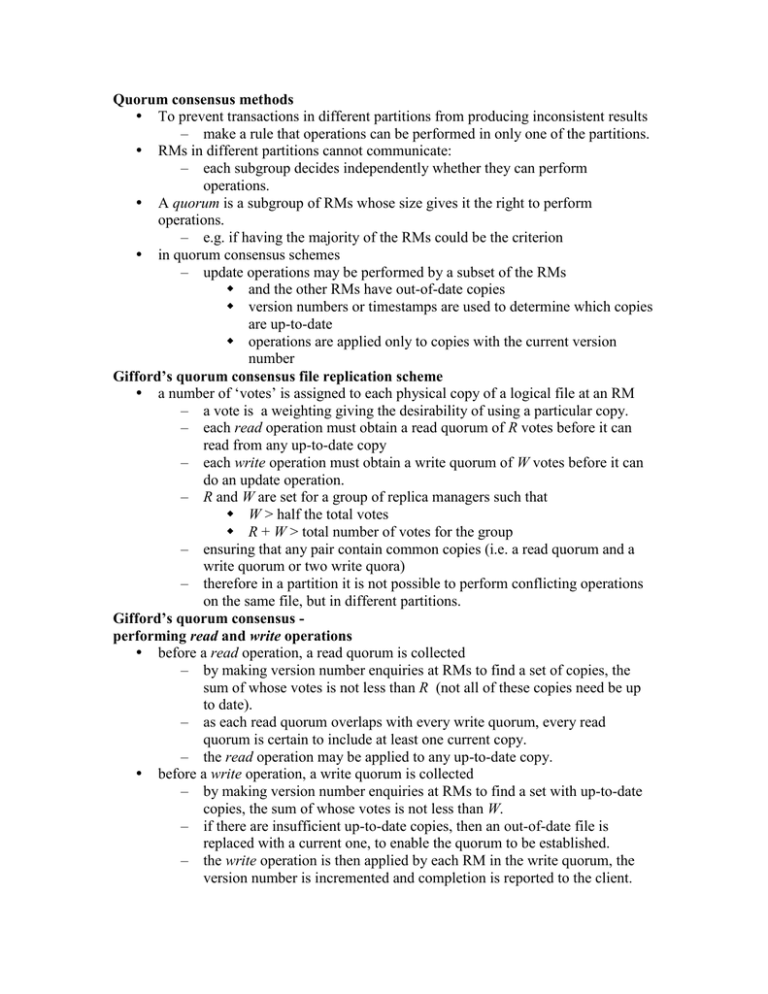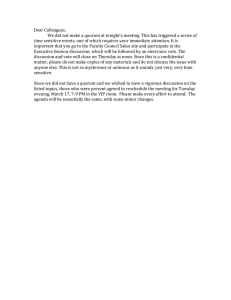Quorum consensus methods
advertisement

Quorum consensus methods To prevent transactions in different partitions from producing inconsistent results – make a rule that operations can be performed in only one of the partitions. RMs in different partitions cannot communicate: – each subgroup decides independently whether they can perform operations. A quorum is a subgroup of RMs whose size gives it the right to perform operations. – e.g. if having the majority of the RMs could be the criterion in quorum consensus schemes – update operations may be performed by a subset of the RMs and the other RMs have out-of-date copies version numbers or timestamps are used to determine which copies are up-to-date operations are applied only to copies with the current version number Gifford’s quorum consensus file replication scheme a number of ‘votes’ is assigned to each physical copy of a logical file at an RM – a vote is a weighting giving the desirability of using a particular copy. – each read operation must obtain a read quorum of R votes before it can read from any up-to-date copy – each write operation must obtain a write quorum of W votes before it can do an update operation. – R and W are set for a group of replica managers such that W > half the total votes R + W > total number of votes for the group – ensuring that any pair contain common copies (i.e. a read quorum and a write quorum or two write quora) – therefore in a partition it is not possible to perform conflicting operations on the same file, but in different partitions. Gifford’s quorum consensus performing read and write operations before a read operation, a read quorum is collected – by making version number enquiries at RMs to find a set of copies, the sum of whose votes is not less than R (not all of these copies need be up to date). – as each read quorum overlaps with every write quorum, every read quorum is certain to include at least one current copy. – the read operation may be applied to any up-to-date copy. before a write operation, a write quorum is collected – by making version number enquiries at RMs to find a set with up-to-date copies, the sum of whose votes is not less than W. – if there are insufficient up-to-date copies, then an out-of-date file is replaced with a current one, to enable the quorum to be established. – the write operation is then applied by each RM in the write quorum, the version number is incremented and completion is reported to the client. – the files at the remaining available RMs are then updated in the background. Two-phase read/write locking is used for concurrency control – the version number enquiry sets read locks (read and write quora overlap) Gifford’s quorum consensus: configurability of groups of replica managers groups of RMs can be configured to give different performance or reliability characteristics – once the R and W have been chosen for a set of RMs: – the reliability and performance of write operations may be increased by decreasing W – and similarly for reads by decreasing R the performance of read operations is degraded by the need to collect a read consensus examples from Gifford – three examples show the range of properties that can be achieved by allocating weights to the various RMs in a group and assigning R and W appropriately – weak representatives (on local disk) have zero votes, get a read quorum from RMs with votes and then read from the local copy



